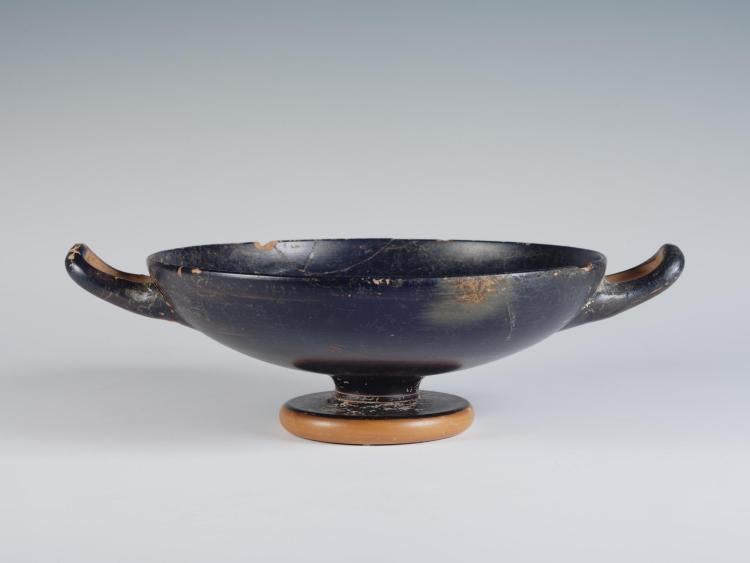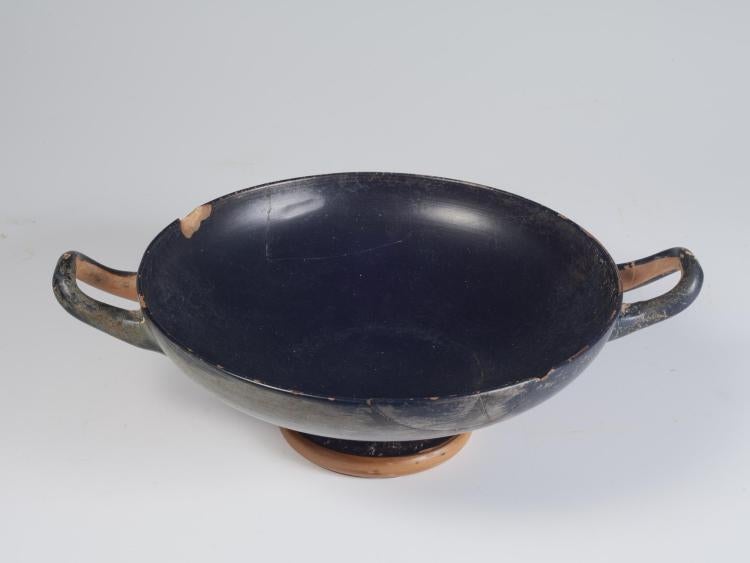2006.35.T, Attic Kylix
Catalogue Entry 

This vase is one of a collection of Greek vases held by the CU Art Museum.
Gift to CU Classics Department
Transferred to CU Museum of Natural History
Transferred to CU Art Museum (2006)
Height: 6.7 cm
Diameter (max.): 23.8 cm
Depth: 17.8 cm
Date: c. 450 B.C.E.
Origin: Athens (Greece)
Description: Black-gloss kylix with flat base and short stem. Shallow and wide bowl with two slightly up-curved handles on either side. Most of cup covered in a shiny black slip, except for underside of handles, exterior ring of base, and two narrow parallel bands at base of stem, which are all reserved in the color of clay.
Additional photos of this vessel show details of the rim, handles, body, and base.
Discussion

The kylix is distinct from other cup shapes in ancient Greece, including the skyphos and the kantharos. A skyphos, such as the later 6th century B.C.E. example in the CU Art Museum's collection, does not have the stem or the handles of a kylix. Kantharoi, including a 4th century B.C.E. example in the CU Art Museum's collection, usually have stems but their bowls and handles differ from those on kylikes.
There are many sub-types of kylikes, but they all have the same function. This particular kylix, with the continuous curve from the lip to the stem, placement of the handles, and style of decoration, resembles a Type B kylix (2).
Although the best-known cups from ancient Greece were elaborately painted, the most commonly used were plain slipped wares like this one. Painted vessels in the red-figure technique or the black-figure technique were often reserved for more formal events and were typically a part of a suite of associated vessels, including mixing kraters and jugs. Wealth in ancient Greece was retained by a select few, while the majority of people belonged to what we would term the middle and lower classes. Finely painted vessels would have cost more than unpainted wares (3). Excavations at the Athenian Agora, the site of public dining in the city, have unearthened an abundance of plain black-slipped drinking vessels.
Comparanda
- Marathon, Marathon Museum K228 (4)
- Marathon, Marathon Museum K210 (5)
- Marathon, Marathon Museum K205 (6)
- Thebes, Archaeological Museum of Thebes 23425 (R.18.255) (7)
Footnotes
- This vase was originally identified as a late 6th century B.C.E. cup and compared with other kylikes dated to around 510-480 B.C.E.
- While searching through the Corpus vasorum antiquorum , I came across a Type C cup (Thebes 23425 (R.18.255)). Similar to the Type B cup, it differs only in a raised fillet separating the foot from the stem. The standard definition of the Type C cup includes a concave rim and I had never heard of the raised fillet as an indicator of Type C cup. Although there is a slight suggestion of a fillet on this kylix in the CU Art Museum's collection, it is not as pronounced as on the Thebes example and I therefore think the CU kylix should retain the Type B classification.
- For other theories on vase medium, decoration and what this black vase might suggest, see M. J. Vickers, "Artful Crafts: The Influence of Metalwork on Athenian Painted Pottery," Journal of Hellenic Studies 105 (1985): 108-128; R.M. Cook, "'Artful Crafts': A Commentary," Journal of Hellenic Studies 107 (1987): 169-171; J. Boardman, "Silver is White," Revue archéologique, Nouvelle Série, Fasc. 2 (1987): 279-295.
- Corpus vasorum antiquorum: Greece Fasc. 7, Marathon Museum (Athens: Academy of Athens, 2001): 44-45, 80, Pl. (390) 23.1-4.
- Corpus vasorum antiquorum: Greece Fasc. 7, Marathon Museum (Athens: Academy of Athens, 2001): 45-46, 80, Fig. 26, PL. (391) 24.1-4.
- Corpus vasorum antiquorum: Greece Fasc. 7, Marathon Museum (Athens: Academy of Athens, 2001): 46, 80, Fig. 27, Pl. (392) 25.1-4.
- Corpus vasorum antiquorum: Greece Fasc. 6, Thebes, Archaeological Museum (Athens: Academy of Athens, 2001): 80, Pl. (351) 73.1-3.
References
- John Boardman, Athenian Red-Figure Vases: the Archaic Period (London: Thames & Hudson, 1975).
- John Boardman, Athenian Red-Figure Vases: the Classical Period (London: Thames & Hudson, 1989).
- Simon Hornblower and Antony Spawforth, eds. The Oxford Classical Dictionary, 3rd ed. (Oxford: Oxford University Press, 2003).
- Brian A. Sparkes and Lucy Talcott. Pots and Pans of Classical Athens. (Princeton: American School of Classical Studies at Athens, 1977).
- Chara Tzavella-Evjen, Greek and Roman Vases and Statuettes from the University of Colorado Collection (Athens: Archaiologikon Deltion, 1973): 192-197.

